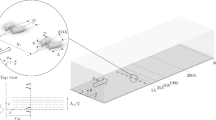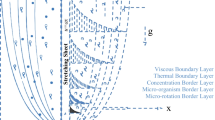Abstract
Purpose
Computational Fluid Dynamics (CFD) simulations are performed to investigate the impact of adding a grid to a two-inlet dry powder inhaler (DPI). The purpose of the paper is to show the importance of the correct choice of closure model and modeling approach, as well as to perform validation against particle dispersion data obtained from in-vitro studies and flow velocity data obtained from particle image velocimetry (PIV) experiments.
Methods
CFD simulations are performed using the Ansys Fluent 2020R1 software package. Two RANS turbulence models (realisable k − ε and k − ω SST) and the Stress Blended Eddy Simulation (SBES) models are considered. Lagrangian particle tracking for both carrier and fine particles is also performed.
Results
Excellent comparison with the PIV data is found for the SBES approach and the particle tracking data are consistent with the dispersion results, given the simplicity of the assumptions made.
Conclusions
This work shows the importance of selecting the correct turbulence modelling approach and boundary conditions to obtain good agreement with PIV data for the flow-field exiting the device. With this validated, the model can be used with much higher confidence to explore the fluid and particle dynamics within the device.











Similar content being viewed by others
Abbreviations
- API:
-
Active Pharmaceutical Ingredients
- CC:
-
Curvature Correction
- CFD:
-
Computational Fluid Dynamics
- DPI:
-
Dry Powder Inhaler
- DPM:
-
Discrete Phase Model
- FPF:
-
Fine Particle Fraction
- LDV:
-
Laser Doppler Velocimetry
- LES:
-
Large Eddy Simulation
- LRN:
-
Low Reynolds Number
- NSE:
-
Navier-Stokes Equations
- PIV:
-
Particle Image Velocimetry
- RANS:
-
Reynolds-Averaged Navier-Stokes
- SBES:
-
Stress Blended Eddy Simulation
- SRS:
-
Scale-Resolving Simulation
- SST:
-
Shear Stress Transport
- URANS:
-
Unsteady Reynolds-Averaged Navier-Stokes
- WALE:
-
Wall-Adapting Local Eddy-viscosity
References
Wong W, Fletcher DF, Traini D, Chan HK, Young PM. The use of computational approaches in inhaler development. Adv Drug Deliv Rev. 2012;64(4):312–22.
Islam N, Cleary MJ. Developing an efficient and reliable dry powder inhaler for pulmonary drug delivery - a review for multidisciplinary researchers. Med Eng Phys. 2012;34(4):409–27.
Sommerfeld M, Cui Y, Schmalfuß S. Potential and constraints for the application of CFD combined with Lagrangian particle tracking to dry powder inhalers. Eur J Pharm Sci. 2019;128:299–324.
Yang Y, Knudsen KS. Comparison of Reynolds averaged Navier-stokes based simulation and large-eddy simulation for one isothermal swirling flow. J Therm Sci. 2012;21(2):154–61.
Milenkovic J, Alexopoulos AH, Kiparissides C. Flow and particle deposition in the Turbuhaler: a CFD simulation. Int J Pharm. 2013;448(1):205–13.
Coates MS, Fletcher DF, Chan HK, Raper JA. Effect of design on the performance of a dry powder inhaler using computational fluid dynamics. Part 1: grid structure and mouthpiece length. J Pharm Sci. 2004;93(11):2863–76.
Menter FR. Two-equation eddy-viscosity turbulence models for engineering applications. AIAA J. 1994;32(8):1598–605.
Coates MS, Chan HK, Fletcher DF, Raper JA. Influence of air flow on the performance of a dry powder inhaler using computational and experimental analyses. Pharm Res. 2005;22(9):1445–53.
Coates MS, Chan HK, Fletcher DF, Raper JA. Effect of design on the performance of a dry powder inhaler using computational fluid dynamics. Part 2: air inlet size. J Pharm Sci. 2006;95(6):1382–92.
Donovan MJ, Kim SH, Raman V, Smyth HD. Dry powder inhaler device influence on carrier particle performance. J Pharm Sci. 2012;101(3):1097–107.
Milenkovic J, Alexopoulos AH, Kiparissides C. Deposition and fine particle production during dynamic flow in a dry powder inhaler: a CFD approach. Int J Pharm. 2014;461(1–2):129–36.
Sommerfeld M, Schmalfuß S. Numerical analysis of carrier particle motion in a dry powder inhaler. J Fluids Eng, Transactions of the ASME. 2016;138(4). 41308.
Longest PW, Son YJ, Holbrook L, Hindle M. Aerodynamic factors responsible for the deaggregation of carrier-free drug powders to form micrometer and submicrometer aerosols. Pharm Res. 2013;30(6):1608–27.
Longest W, Farkas D. Development of a new inhaler for high-efficiency dispersion of spray-dried powders using computational fluid dynamics (CFD) modeling. AAPS J. 2019;21(2):1–15.
Gomes dos Reis L, Chaugule V, Fletcher DF, Young PM, Traini D, Soria J. In-vitro and particle image velocimetry studies of dry powder inhalers. Int J Pharm. 2021; 592, p.119966.
Ansys ® Fluent 2020R1;. Available from: https://www.ansys.com/products/fluids/ansys-fluent.
Shih TH, Liou WW, Shabbir A, Yang Z, Zhu J. A new k-ϵ eddy viscosity model for high reynolds number turbulent flows. Comput Fluids. 1995;24(3):227–238.
Smirnov PE, Menter FR. Sensitization of the SST turbulence model to rotation and curvature by applying the Spalart-Shur correction term. J Turbomach. 2009;131(4):1–8.
Alahmadi YH, Nowakowski AF. Modified shear stress transport model with curvature correction for the prediction of swirling flow in a cyclone separator. Chem Eng Sci. 2016;147:150–65.
Menter F. Stress-blended eddy simulation (SBES) - A new paradigm in hybrid RANS-LES modeling. Notes Numer Fluid Mech Multidiscip Des. 2018;137:27–37.
Nicoud F, Ducros F. Subgrid-scale stress modelling based on the square of the velocity gradient tensor. Flow Turbul Combust. 1999;62(3):183–200.
Brown GJ, Fletcher DF, Leggoe JW, Whyte DS. Application of hybrid RANS-LES models to the prediction of flow behaviour in an industrial crystalliser. Appl Math Model. 2020;77:1797–819.
Bharadwaj R, Smith C, Hancock BC. The coefficient of restitution of some pharmaceutical tablets/compacts. Int J Pharm. 2010;402(1–2):50–6.
Zuurman K, Riepma KA, Bolhuis GK, Vromans H, Lerk CF. The relationship between bulk density and compactibility of lactose granulations. Int J Pharm. 1994;102(1–3):1–9.
Author information
Authors and Affiliations
Corresponding author
Additional information
Publisher’s Note
Springer Nature remains neutral with regard to jurisdictional claims in published maps and institutional affiliations.
Rights and permissions
About this article
Cite this article
Fletcher, D.F., Chaugule, V., Gomes dos Reis, L. et al. On the Use of Computational Fluid Dynamics (CFD) Modelling to Design Improved Dry Powder Inhalers. Pharm Res 38, 277–288 (2021). https://doi.org/10.1007/s11095-020-02981-y
Received:
Accepted:
Published:
Issue Date:
DOI: https://doi.org/10.1007/s11095-020-02981-y




